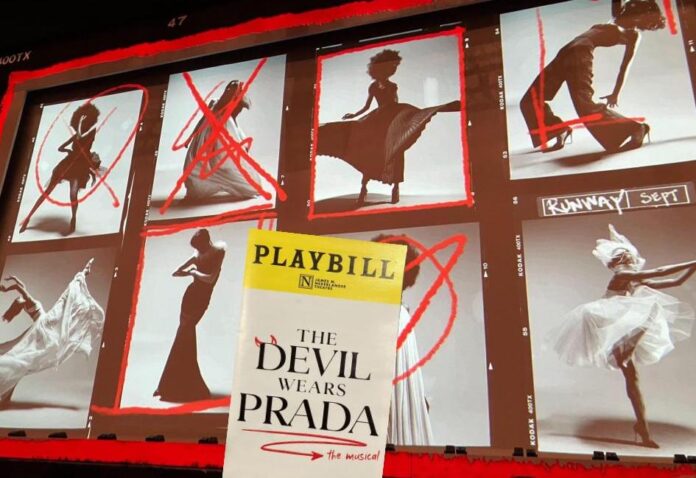Spoiler alert: “The Devil Wears Prada” may have come out in 2006, but it hasn’t been forgotten — at least by certain segments of the population. A new musical based on the film recently concluded a tryout in Chicago before it makes its inevitable move to Broadway, and despite several shortcomings (some of which are easily remedied and some of which are not), it survives on the strength of its actors and source material. The crowd — which featured more gay men than the recent revival of “Company” — came to see the fashion and they came to see the Devil, and while they got some of each, there could and should have been so much more.
Beth Leavel, a Tony-Award winner for “The Drowsy Chaperone” is very good as the Lucifer-adjacent Miranda Priestly who terrorizes, then inspires her young assisstant Andy Sachs (played by Taylor Iman-Jones). Leavel doesn’t try to emulate Meryl Streep, but she also doesn’t shy away from the Streep-like choices that made the movie iconic. In her eleventh hour number, which takes place at Paris Fashion Week and is the best song of the entire show, Leavel channels her own intriguing version of ego and villainy that solidifies the role as something other than a facsimile of the film.
However, despite being ripe for the change, there wasn’t nearly enough Miranda on stage. The show’s opening number, a summary of Andy’s college achievements and trouble finding work in New York, would be better off discarded. Andy sings about her job search and then immediately tells Miranda the exact same thing. Director Anna D. Shapiro could have easily ditched the redundancy and opened instead at the offices of Runway, putting Andy and Miranda together for the first song. After all, Andy’s story exists only as a vehicle for us to experience Miranda in all her glory. The more we see of them together, the better.
Complicating the lack of Miranda are book writer Kate Weatherhead and lyricist Shaina Taub’s attempts to change the film dialogue for the sake of uniqueness. When it comes to character choices made by the actors, as in the case of Leavel, the departures from the film work well. But when such differences are forced by the writers, including some truly awkward lines of dialogue and swapping out designer names for no reason, they bring the show precipitously down.
The adage “great writers steal” usually isn’t meant in the literal sense, but in this case, Weatherhead and Taub had permission to lift any lines from the film they wished. And while several iconic scenes made it into the show, several more were changed for the worse. In the film, first assistant Emily Charlton comes down with a cold right before the magazine’s gala event, prompting Miranda to make Andy attend. In the musical, rather than having a cold, Emily trips and falls, and Miranda calls her, confusingly, “challenged by verticality,” before dragging Andy along. Such heavy-handed attempts to give audiences something new fall flat. The new changes ruin the rhythm of the dialogue, which was tuned perfectly in the film, and they confuse rather than engage.
Thankfully, the actors do a better job at delivering the magic of the source material. Nigel, played by “Hamilton” star Javier Muñoz, gets more screen time in this iteration, including a touching number about growing up queer that Muñoz sells despite some occasionally sappy lyrics. Likewise, Emily, played by Megan Masako Haley, is given her own song to open the second act, a jazzy dance set that lays out the character’s jealousy of Andy. Haley handles the number with ease, and the song should make it to Broadway.
Other parts of the show work reasonably well together. Elton John’s music is light and matches the energy of the story (there are no “I Dreamed A Dream” moments here, for good reason). The melodies, which infuse the film’s most famous “cerulean” scene and a memorable runway number during Fashion Week, feature hints of “Billy Elliot,” “Bennie and the Jets” and other Elton classics. Choreographer James Aslop infuses angular fashion magazine poses and flowing ballet movements into the dance numbers (including two fantastic same-sex pairs of Parisians). And Christine Jones & Brett Banakis’s sets work well within the confines of the stage, including walls of opaque and translucent glass for the various scenes in the Runway offices. Only Arianne Phillips’ costumes fall flat, especially in the first act, where the serious Runway employees, who are supposed to care about designer fashion, seem to be as casually dressed as Andy. Perhaps when the show gets to Broadway there will be more of a budget for clothes.
Director Shapiro ferries the audience deftly through most of the major moments of the film, with the only notable omissions being between Andy and her boyfriend, Nate, whose role, along with Andy’s two friends, has been cut down from the movie. The choice to limit Nate makes one wonder if the character could have been removed entirely to make room for more Miranda.
Shapiro does, however, flub the ending significantly, both in scope and in style. Rather than rely on the talented Leavel and Jones to bring out the intensity of the pair’s final scene, certain props are used in underwhelming and confusing ways. Here’s hoping the last twenty minutes are completely reworked when the show gets to New York.
Writing and that final scene aside, the show has a clear roadmap to improve. Almost all reviews of “The Devil Wears Prada” have been negative, but one senses that the audience was much more forgiving. There were laughs and applause where there were supposed to be, and with some tweaks, the show can, and should, do well at whatever midtown theater it winds up in.
While one might think, watching Chanel boots instead become Louboutin boots, “if it isn’t broke, don’t fix it,” perhaps the better advice to the team behind ‘Devil’ is “if it isn’t broke, don’t break it.”

